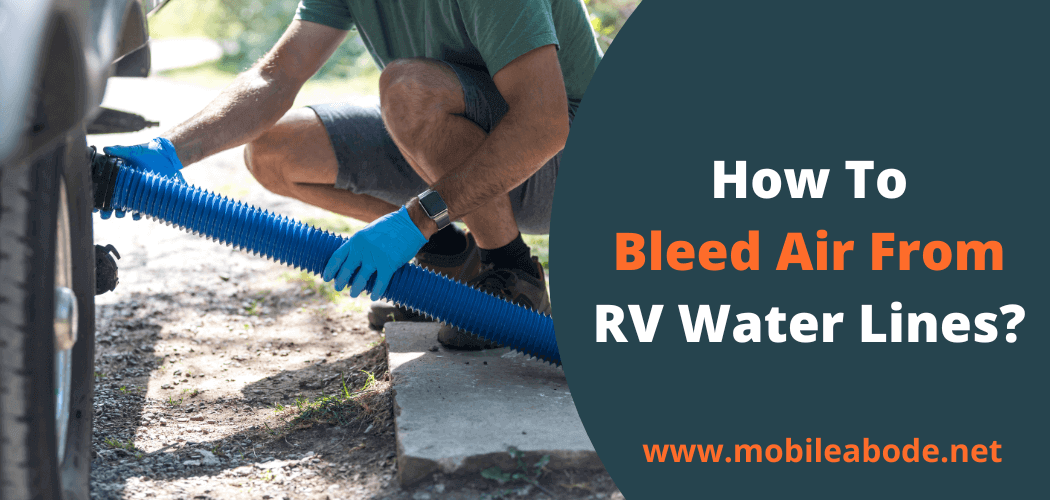RVs come with a variety of water systems, some of which include pressurized water tanks and others that rely on gravity to feed fresh water into the unit. No matter what type of system your RV has, you’ll need to bleed air out of the lines periodically to ensure proper function.
RVers know that maintaining water pressure is important for both filling and flushing the tanks. One way to maintain water pressure is to bleed the air from the lines. Here’s a guide on how to do it.
How To Bleed Air From RV Water Lines? Step by Step
Why do we need to bleed air from RV water lines?
There are a few reasons why you might need to bleed air from your RV’s water lines:
- To ensure that the water pump is working properly
- To improve water flow throughout the unit
- To prevent damage to the water pump
- To clear any airlocks that might have formed in the lines
Step by Step Guide: To Bleed Air To Bleed Air From RV Water Lines
- Locate the water pump: The first step is to locate the water pump. This is usually located near the fresh water tank.
- Turn off the water pump: Once you’ve found the water pump, you’ll need to turn it off. This can usually be done by flipping a switch or turning a knob.
- Find the bleeder valve: The next step is to find the bleeder valve. This is usually located on the water pump itself.
- Open the bleeder valve: Once you’ve found the bleeder valve, you’ll need to open it. This can usually be done by turning a knob or lever.
- Bleed the air from the lines: Once the bleeder valve is open, you’ll need to bleed the air from the lines. To do this, you’ll need to run water through the system until all of the air has been purged.
- Close the bleeder valve: Once all of the air has been purged from the system, you’ll need to close the bleeder valve. This can usually be done by turning a knob or lever.
- Turn on the water pump: Finally, you’ll need to turn the water pump back on. This can usually be done by flipping a switch or turning a knob.
Now that you know how to bleed air from RV water lines, you can keep your unit’s water system functioning properly. This simple maintenance task can save you a lot of time and money in the long run.
Also Read: Where To Fill RV Water Tank?
Tips For Bleed Air from RV Water Lines
- Always bleed the air from your RV’s water lines when you first set up camp. This will ensure that the water pump is working properly and that you have good water pressure throughout the unit.
- If you notice a drop in water pressure, Bleed the Air from RV Water Lines as soon as possible. This will help to prevent damage to the water pump and improve water flow throughout the unit.
- Be sure to close the bleeder valve when you’re finished bleeding the air from the lines. This will prevent any water from escaping and will keep your RV’s water system functioning properly.
- If you have any questions about how to bleed air from RV water lines, be sure to consult your owner’s manual. This will give you specific instructions for your unit.
- Remember, bleeding the air from your RV’s water lines is a simple maintenance task that can save you a lot of time and money in the long run. So, don’t hesitate to do it regularly.
Did You Know: How to Remove Air from Water Pipes in a Mobile Home?
FAQS-Bleed Air From RV Water Lines
How do you fix low water pressure in an RV?
There are a few things you can do to fix low water pressure in an RV:
- Check the water pump: The first thing you should do is check the water pump. This is usually located near the fresh water tank. If the pump is turned off, then it can cause low water pressure.
- Check the water lines: Another thing you can do is check the water lines. If there are any airlocks or blockages, then this can cause low water pressure.
- Bleed the air from the lines: If there is air in the lines, then this can also cause low water pressure. To fix this, you’ll need to bleed the air from the lines.
- Check the water filter: If your RV has a water filter, then it might be clogged. This can also cause low water pressure.
- Check the fixtures: Finally, you should check the fixtures themselves. If they’re not functioning properly, then this can also cause low water pressure.
If you’re still having trouble with low water pressure, then it might be time to call a professional. They can help you troubleshoot the issue and get your RV’s water system back up and running properly.
What PSI should RV water pressure be?
RV water pressure should be between 40 and 50 PSI. If it’s below 40 PSI, you might have low water pressure. If it’s above 50 PSI, you might have high water pressure. Either way, it’s a good idea to bleed the air from your RV’s water lines to ensure proper function.
Is a water pressure regulator necessary for RV?
A water pressure regulator is not strictly necessary for RV, but it’s a good idea to have one. This will help to protect your RV’s plumbing from high water pressure. It can also help to improve water flow throughout the unit.
Where is water pressure regulator located on an RV?
The water pressure regulator is usually located near the fresh water tank. It might also be located near the water pump or in the main water line.
How often should I replace my RV water pressure regulator?
You should replace your RV’s water pressure regulator every few years. This will help to ensure that it’s working properly and that your RV’s plumbing is protected from high water pressure.
Final Words
Now that you know how to bleed air from RV water lines, bleeding your RV’s water lines can help keep them functioning properly and prevent any leaks or other problems down the road. This simple maintenance task can save you a lot of time and money in the long run.
Remember, if you have any questions about how to bleed air from RV water lines, be sure to consult your owner’s manual. This will give you specific instructions for your unit.

